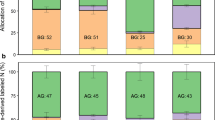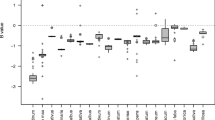Abstract
Leaves from over 1000 Brazilian native plants growing in the cerrado and neighbouring regions were sampled for C and N content. Half of these were analysed for 15N and further samples for 13C and ash content. Nodulated legumes from all three sub-families were included, together with two types of reference plant, non-nodulated legumes and non-legumes. Particular emphasis was placed on the large caesalpinioid genus Chamaecrista which is here for the first time reported to fix nitrogen in its native habitats. Woody and herbaceous species of this and other nodulated genera, with the exception of the mimosoid tree Stryphnodendron, showed evidence of nitrogen fixation. Amounts fixed were site-specific as was the 15N signature of reference plants. There was no evidence that nodulated legumes had higher leaf N than non-nodulated legumes: both were higher than non-legumes. Several species of Chamaecrista from section absus and species of Stryphnodendron had carbon contents of 50–55%, higher than previously reported for leaves. This was coupled with low (1–3%) ash contents. The 13C values of plants with ≥49% C were significantly more negative than those with <49% C: most species in the former group were woody and most in the latter group herbaceous. Mimosa pudica was unusual in having a wide range of percent C, percent ash and 13C values; these parameters were significantly correlated. It is concluded that Brazilian native legumes can fix significant amounts of nitrogen in the nutrient-poor cerrado soils. Consideration of mineral and lipid nutrition will be necessary in order fully to understand relations between 13C, carbon content and other physiological parameters.
Similar content being viewed by others
References
Alexander, IJ (1989) Systematics and ecology of ectomycorrhizal legumes. In: Stirton CH, Zaruchhi JL (eds) Advances in legume biology (Monographs in systematic botany). Missouri Botanical Garden, Number 29, St. Louis Missouri, USA, pp 607–624
Barnet YM, Catt PC (1991) Distribution and characteristics of root nodule bacteria isolated from Australian Acacia spp. Plant Soil 135: 109–120
Corby HDL (1981) The systematic value of leguminous root nodules. In: Polhill RM, Raven PH (eds) Advances in legume systematics, part 2. Royal Botanic Gardens, Kew, pp 657–669
Faria SM de, Franco AA, Jesus RM de, Menandro M de S, Baitello JB, Mucci ESF, Döbereiner J, Sprent JI (1984) New nodulating legume trees from south-east Brazil. New Phytol 98: 317–328
Faria SM de, McInroy S, Sprent JI (1987). The occurrence of infected cells, with persistent infection threads, in legume root nodules. Can J Bot 65: 533–538
Farquhar GD, Hubick KT, Condon AG, Richards RA (1988) Carbon isotope fractionation and plant water-use efficiency. In: Rundel PW, Ehleringer JR, Nagy K (eds) Applications of stable isotope ratios to ecological research. Springer, Berlin Heidelberg New York, pp 21–40
Goedert WJ (1983) Management of the cerrado soils of Brazil: a review. J Soil Sci 34: 405–428
Handley LL, Odee D, Scrimgeour CM (1994) δ15N and δ13C patterns in savanna vegetation: dependence on water availability and disturbance. Funct Ecol 8: 306–314
Haridasan M (1982) Aluminium accumulation by some cerrado native species of central Brazil. Plant Soil 65: 265–273
Harley JL, Smith SE (1983) Mycorrhizal symbiosis. Academic Press, London
Heaton THE (1987) The 15N/14N ratios of plants in South Africa and Namibia: relationship to climate and coastal/saline environments. Oecologia 74: 236–246
Högberg P (1990) 15N natural abundance as a possible marker of the ectomycorrhizal habit of trees in mixed African woodlands. New Phytol 115: 483–486
Hubick K, Farquhar G (1989) Carbon isotope discrimination and the ratio of carbon gained to water lost in barley cultivars. Plant Cell Environ 12: 795–804
Irwin HS, Barneby RC (1982) The American Cassiinae. A synoptical revision of leguminosae tribe Cassieae subtribe Cassiinae in the New World. Mem NY Bot Gard 35: 1–454
Kirkbride JH (1984) Legumes of the cerrado. Pesquisa agropecuaria brasileira. Brasilia 19 s/n, 23–46
Ledgard SF (1989) Nutrition, moisture and rhizobial strain influence isotopic fractionation during N2 fixation in pasture legumes. Soil Biol Biochem 21: 65–68
Lewis GP (1987) Legumes of Bahia. Royal Botanic Gardens, Kew
Masle J, Farquhar GD, Wong SC (1992) Transpiration ratio and plant mineral content are related among genotypes of a range of species. Aust Plant Physiol 19: 709–721
Masle J, Shin JS, Farquhar GD (1993) Analysis of restriction fragment length polymorphisms associated with variation of carbon isotope discrimination among ecotypes of Arabidopsis thaliana. In: Ehleringer JR, Hall AE, Farquhar GD (eds) Stable isotopes and plant carbon-water relations. Academic Press, New York, pp 371–386
McGee P (1986) Mycorrhizal associations of plant species in a semiarid community. Aust J Bot 34: 585–593
McKey D (1994) Legumes and nitrogen: the evolutionary ecology of a nitrogen-demanding lifestyle. In: Sprent JI, McKey D (eds) Advances in legume systematics. 5. The nitrogen factor. Royal Botanic Gardens, Kew, pp 211–228
Nadelhoffer KJ, Fry B (1994) Nitrogen isotope studies in forest ecosystems. In: Lajtha K, Michener RH (eds) Stable isotopes in ecology and environmental science. Blackwell, Oxford, pp 22–44
Naisbitt T, James EK, Sprent JI (1992) The evolutionary significance of the legume genus Chamaecrista, as determined by nodule structure. New Phytol 122: 487–492
Peoples MB, Faizah AW, Rerkasem B, Herridge DF (1989) Methods for evaluating nitrogen fixation by nodulated legumes in the field. ACIAR (Australian Centre for Agricultural Research), Canberra
Piccolo MC, Neill C, Cerri CC (1994) Natural abundance of 15N in soils along forest-to-pasture chronosequence in the western Brazilian Amazon Basin. Oecologia 99: 112–117
Polhill RM, Raven JR (eds) (1981) Advances in legume systematics part 1. Royal Botanic Gardens, Kew
Raven JA (1988) Acquisition of nitrogen by the shoots of land plants: its occurrence and implications for acid-base regulation. New Phytol 109: 1–20
Schulze E-D, Gebauer G, Ziegler H, Lange OL (1991) Estimates of nitrogen fixation by trees on an aridity gradient in Namibia. Oecologia 88: 451–455
Shearer G, Kohl DH (1993) Natural abundance of 15N: fractional contribution of two sources to a common sink and use of isotope discrimination In Knowles R, Blackburns TS (eds) Nitrogen isotope techniques. Academic Press, New York, pp 89–123
Sicardi de Mallorca M, Izaguirre-Mayoral ML (1994) A comparative evaluation of the symbiotic N2-fixation and physiological performance of thirty-six native legume species collected in a tropical savanna during the rainy and dry seasons. Symbiosis 16: 225–247
Sprent JI (1980) Root nodule anatomy, type of export product and evolutionary origin in some Leguminosac. Plant Cell Environ 3: 35–43
Sprent JI (1989) Which steps are essential for the formation of functional legume nodules? New Phytol 111: 129–153
Sprent JI (1994a) Evolution and diversity in the legume-rhizobium symbiosis: chaos theory? Plant Soil 161: 1–10
Sprent JI (1994b) Nitrogen acquisition systems in the Leguminosae. In: Sprent JI, McKey D (eds) Advances in legume systematics. 5. The nitrogen factor. Royal Botanic Gardens, Kew, pp 1–16
Strickland RW, Greenfield RG, Wilson GPM, Harvey GL (1985) Morphological and agronomic attributes of Cassia rotundifolia Pers., C. pilosa L. and C. trichopoda Benth., potential forage legumes for northern Australia. Aust J Exp Agric 25: 100–108
Sutherland JM, McInroy SG, James, EK, Naisbitt, T (1994) Nodule structure with special reference to the tribes Sophoreae, Genisteae and Thermopsideae. In: Sprent JI, McKey D (eds) Advances in legume systematics. 5. The nitrogen factor. Royal Botanic Gardens, Kew, pp 41–55
Vitousek PM, Shearer G, Kohl DH (1989) Foliar 15N natural abundance in Hawaiian rainforest: patterns and possible mechanisms. Oecologia 78: 383–388
Warcup JH (1980) Ectomycorrhizal associations of Australian indigenous plants. New Phytol 85: 531–535
Whitty PW, Powell W, Sprent JI (1994) Molecular separation of genera in Cassiinae (Leguminosae), and analysis of variation in the nodulating species of Chamaecrista. Mol Ecol 3: 507–515
Yoneyama T, Ohtani T (1983) Variations of natural 13C abundances in leguminous plants. Plant Cell Physiol 24: 971–977
Yoneyama T, Muraoka T, Murakami T, Boonkerd N (1993) Natural abundance of 15N in tropical plants with emphasis on tree legumes. Plant Soil 153: 295–304
Author information
Authors and Affiliations
Rights and permissions
About this article
Cite this article
Sprent, J.I., Geoghegan, I.E., Whitty, P.W. et al. Natural abundance of 15N and 13C in nodulated legumes and other plants in the cerrado and neighbouring regions of Brazil. Oecologia 105, 440–446 (1996). https://doi.org/10.1007/BF00330006
Received:
Accepted:
Issue Date:
DOI: https://doi.org/10.1007/BF00330006




